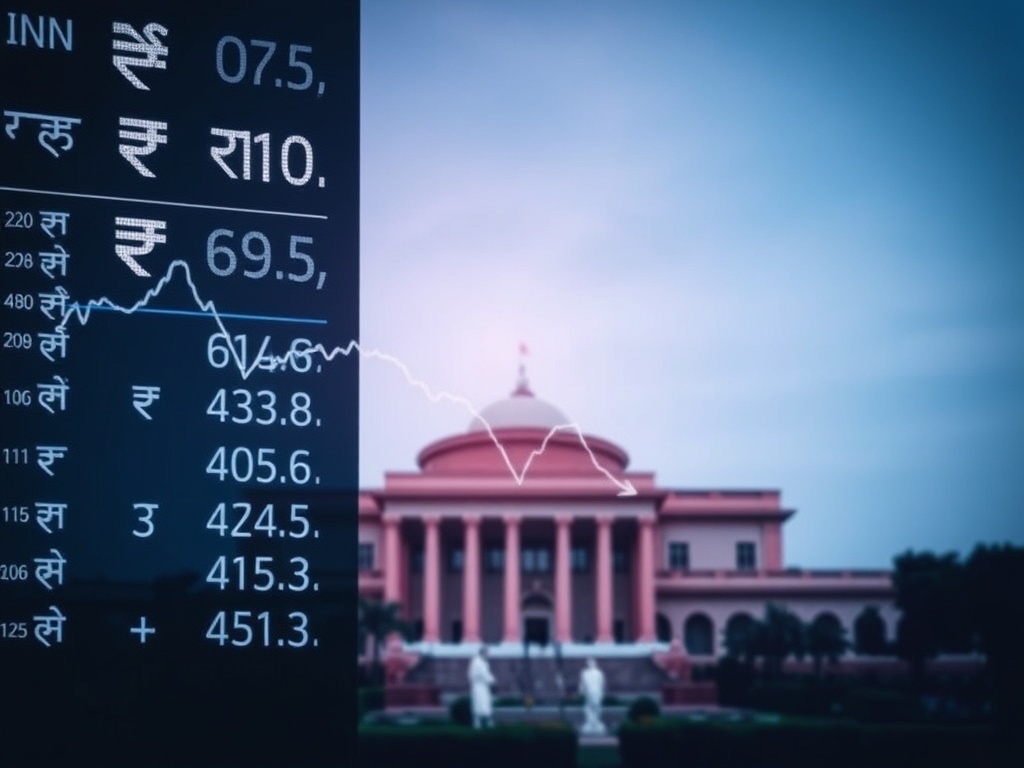BitcoinWorld

Indian Rupee: Critical Weakness Grips Asia FX Ahead of Pivotal RBI Rate Decision
In the dynamic world of financial markets, volatility is a constant companion. For those immersed in cryptocurrencies, the experience of rapid market shifts is well-known. However, this inherent unpredictability is not exclusive to digital assets. Traditional markets, particularly the foreign exchange (FX) landscape, are currently experiencing significant turbulence, with the Indian Rupee facing a particularly challenging period. As investors and market watchers keenly await the Reserve Bank of India’s (RBI) upcoming rate decision, understanding the forces at play becomes paramount. What drives these movements, and what implications do they hold for the broader financial ecosystem?
The Indian Rupee‘s Precarious Position: A Deep Dive
The Indian Rupee has recently found itself in a vulnerable state, hovering near record lows against the strengthening US Dollar. This weakening trend is not an isolated event but rather a confluence of several global and domestic factors that exert pressure on the currency.
- Strong US Dollar: The primary driver behind the Rupee’s depreciation is the relentless strength of the US Dollar. A robust US economy, coupled with the Federal Reserve’s hawkish stance on interest rates, makes the dollar an attractive safe-haven asset, drawing capital away from emerging markets.
- Rising Crude Oil Prices: India is a major importer of crude oil. Higher global oil prices mean a larger import bill, which puts downward pressure on the Rupee as more dollars are needed to pay for these imports. This trade deficit expansion contributes to the currency’s weakness.
- Foreign Institutional Investor (FII) Outflows: Global risk aversion often leads to FIIs pulling money out of emerging markets like India. When foreign investors sell their Indian assets (equities, bonds) and repatriate funds, it creates a demand for dollars, further weakening the Indian Rupee.
- Global Economic Slowdown Concerns: Broader worries about a potential global economic slowdown can also deter foreign investment, impacting capital flows into India and other developing economies.
Understanding Asia FX Weakening Trends: A Regional Perspective
The challenges faced by the Indian Rupee are not unique within the continent. A broader trend of Asia FX weakening has been observed, as various Asian currencies grapple with similar external pressures. The interconnectedness of global finance means that factors affecting one major economy can ripple across the region.
Several factors contribute to this regional currency depreciation:
- US Federal Reserve’s Monetary Tightening: As the US Fed continues to raise interest rates, the yield differential between US assets and those in Asia narrows, making US investments more appealing. This encourages capital outflows from Asian markets.
- China’s Economic Slowdown: China’s economic performance significantly impacts its Asian trading partners. A slowdown in China can reduce demand for goods and services from neighboring countries, affecting their export revenues and, consequently, their currencies.
- Geopolitical Tensions: Regional and global geopolitical uncertainties can also prompt investors to seek safer assets, leading to capital flight from Asian markets and contributing to Asia FX weakening.
To illustrate the regional trend, consider the recent performance of select Asian currencies (illustrative, not real-time data):
| Currency | Recent Performance (Illustrative) | Key Factors |
|---|---|---|
| Japanese Yen (JPY) | Significant depreciation | Divergence in monetary policy (BOJ maintaining ultra-low rates vs. Fed hikes) |
| South Korean Won (KRW) | Moderate weakening | Exposure to global trade, tech sector slowdown, US Dollar strength |
| Thai Baht (THB) | Slight weakening | Tourism recovery, but global economic uncertainty |
| Malaysian Ringgit (MYR) | Notable depreciation | Commodity prices, political stability, US Dollar strength |
The Anticipated RBI Monetary Policy Decision: What to Expect?
All eyes are now on the Reserve Bank of India as it prepares to announce its latest RBI monetary policy decision. This decision is critical, as it will signal the central bank’s stance on managing inflation, supporting economic growth, and stabilizing the Indian Rupee. Market participants are keenly debating the possible outcomes:
- Interest Rate Hike: The RBI might opt for another interest rate hike to combat persistent inflation and support the Rupee. Higher rates can make the Rupee more attractive to foreign investors, potentially drawing in capital.
- Status Quo (Hold Rates): The central bank could choose to maintain the current rates, perhaps to assess the impact of previous hikes on economic growth, especially if there are signs of a slowdown.
- Change in Stance: Beyond rate changes, the RBI’s commentary on its future outlook and stance (e.g., ‘withdrawal of accommodation’ vs. ‘neutral’) will be closely scrutinized for clues on future policy direction.
The RBI’s challenge is to strike a delicate balance between curbing inflation, which erodes purchasing power, and supporting economic growth, which is vital for job creation and prosperity. Its decision will have significant ramifications for the Rupee’s trajectory and the broader financial markets.
Navigating the Global Forex Market Volatility
The current environment of currency weakness is part of a larger narrative playing out in the Global Forex market. This market, the largest and most liquid financial market in the world, is constantly influenced by a multitude of factors, creating inherent volatility. Understanding these broader influences is key to comprehending the local impact.
Key drivers of volatility in the Global Forex market include:
- Interest Rate Differentials: The difference in interest rates between two countries is a primary driver of currency movements. When a country’s central bank raises rates, its currency tends to strengthen as investors seek higher returns.
- Geopolitical Events: Wars, political instability, and international disputes can trigger risk aversion, leading investors to flock to safe-haven currencies like the US Dollar, Swiss Franc, or Japanese Yen.
- Commodity Prices: Countries that are major exporters or importers of commodities (like oil, metals, or agricultural products) see their currencies directly affected by fluctuations in these prices.
- Economic Data: Inflation figures, GDP growth rates, employment reports, and trade balances all provide insights into an economy’s health, influencing investor sentiment and currency valuations.
The current environment, characterized by aggressive rate hikes by major central banks (excluding some like the BOJ), elevated inflation, and geopolitical uncertainties, creates a challenging backdrop for many currencies, including those in Asia.
Implications of Currency Fluctuations for Investors and Businesses
The ongoing currency fluctuations, particularly the weakening of the Indian Rupee and other Asian currencies, have tangible impacts on various stakeholders. For businesses, investors, and even everyday consumers, these shifts translate into real economic consequences.
Challenges:
- Higher Import Costs: A weaker Rupee means that imported goods, from electronics to raw materials and crucial crude oil, become more expensive. This can fuel domestic inflation and increase input costs for businesses.
- Reduced Corporate Earnings (for some): Companies that rely heavily on imported components or have significant foreign currency-denominated debt may see their profit margins squeezed due to higher costs and increased debt servicing expenses.
- Inflationary Pressures: The pass-through effect of higher import costs can contribute to overall inflation, eroding the purchasing power of consumers.
Potential Opportunities (for some):
- Boost for Exporters: A weaker currency makes a country’s exports more competitive in international markets, as foreign buyers can purchase goods and services at a lower cost in their own currency.
- Attracting Foreign Investment (potentially): While initial outflows might occur due to risk aversion, a relatively weaker currency can make domestic assets (like stocks and real estate) appear cheaper and more attractive to foreign investors in the long run, especially if the economic fundamentals remain strong.
Actionable Insights for Businesses:
Businesses exposed to currency risks can consider strategies to mitigate the impact of currency fluctuations:
- Hedging: Using financial instruments like forward contracts or options to lock in exchange rates for future transactions can provide certainty.
- Diversification: Spreading investments across different currencies or markets can reduce overall exposure to a single currency’s volatility.
- Local Sourcing: Where feasible, increasing reliance on local suppliers can reduce exposure to import costs tied to foreign exchange rates.
Conclusion: Navigating the Storm
The current environment for the Indian Rupee and broader Asia FX weakening trends underscores the complex interplay of global economic forces, central bank policies, and investor sentiment. The upcoming RBI monetary policy decision is a pivotal moment that will shape the immediate trajectory of the Rupee and provide crucial signals to the Global Forex market. While currency fluctuations present challenges, they also highlight the need for robust economic management and adaptable business strategies. As markets continue to evolve, staying informed and understanding these fundamental drivers remains essential for navigating the financial landscape successfully.
To learn more about the latest Forex market trends, explore our article on key developments shaping the Indian Rupee and global interest rates affecting liquidity and institutional adoption.
This post Indian Rupee: Critical Weakness Grips Asia FX Ahead of Pivotal RBI Rate Decision first appeared on BitcoinWorld and is written by Editorial Team





